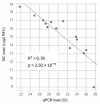Potential of Molecular Culture in Early Onset Neonatal Sepsis Diagnosis: A Proof of Principle Study
- PMID: 37110382
- PMCID: PMC10145526
- DOI: 10.3390/microorganisms11040960
Potential of Molecular Culture in Early Onset Neonatal Sepsis Diagnosis: A Proof of Principle Study
Abstract
Delay in the time-to-positivity of a peripheral blood culture (PBC), the gold standard for early onset neonatal sepsis (EOS) diagnosis, has resulted in excessive use of antibiotics. In this study, we evaluate the potential of the rapid Molecular Culture (MC) assay for quick EOS diagnosis. In the first part of this study, known positive and spiked blood samples were used to assess the performance of MC. In the in vivo clinical study, the second part of this study, all infants receiving antibiotics for suspicion of EOS were included. At initial EOS suspicion, a blood sample was collected for PBC and MC. MC was able to detect bacteria present in the spiked samples even when the bacterial load was low. In the clinical study, MC was positive in one infant with clinical EOS (Enterococcus faecalis) that was not detected by PBC. Additionally, MC was positive in two infants without clinical sepsis (Streptococcus mitis and multiple species), referred to as contamination. The other 37 samples were negative both by MC and PBC. MC seems to be able to detect bacteria even when the bacterial load is low. The majority of MC and PBC results were comparable and the risk for contamination and false positive MC results seems to be limited. Since MC can generate results within 4 h following sampling compared with 36-72 h in PBC, MC may have the potential to replace conventional PBC in EOS diagnostics in order to guide clinicians on when to discontinue antibiotic therapy several hours after birth.
Keywords: IS-pro; diagnosis; early onset sepsis; molecular culture; neonates.
Conflict of interest statement
Andries Budding is co-owner of inbiome. Martine Bos is an employee of inbiome.
Figures


References
-
- National Institute for Health and Clinical Excellence Neonatal Infection (Early Onset): Antibiotics for Prevention and Treatment (NICE Guideline 149) 2012. [(accessed on 10 December 2020)]. Available online: https://www.nice.org.uk/guidance/CG149.
Grants and funding
LinkOut - more resources
Full Text Sources

